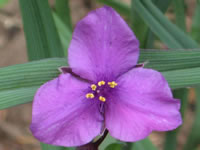How to Grow and Care for Spiderwort Plants
Tradescantia x andersoniana
            
Spiderworts are clump forming perennials that form loose, 15"-24" tall mounds of narrow,
strap-like leaves that can spread to about three feet.
From early through mid-summer they continuously produce butterfly attracting, 1"-1½", three petaled,
triangular flowers
on top of stems that rise slightly above the foliage.
Spiderwort flowers only last for one day, but the flower heads produce clusters with a multitude of buds,
ready to open in succession as the previous day's flower fades away.
|

|
Growing requirements for Spiderwort Plants
Spiderworts are hardy in USDA zones 4-9.
They are able to grow in almost any amount of light, from full sun to full shade,
but grow, look and bloom best when grown in dappled sun or light shade.
In full sun, Spiderwort plants must be kept constantly moist.
Tradscantia are adaptable to many types of soil as long as it is moist and well-drained,
but they'd be happiest if you'd add in lots of compost or other organic material when you prepare your planting hole.
Set plants 12"-15" apart in the garden at any time after the danger of frost
has passed in the spring.
Cut plants back to the ground after the main flush of flowers to encourage new growth and a second round of blooms.
In cool regions, regrowth will begin almost immediately.
In areas with hot summers, Spiderwort plants may lay dormant until the fall.
|
|
Propagating Spiderworts and Growing them from Seed
For propagation and to contain their spreading growth, Spiderwort plants should be divided every 3-4 years in either the spring or in early fall.
Spiderworts can easily be propagated with tip cuttings which should be taken in the spring or early summer.
Spiderwort seeds collected from hybrid varieties may not come true to the original color.
Seeds can be sown directly in the garden from early spring up until two months before the first killing frost.
If starting seeds indoors, maintain a temperature of 70° in the growing medium until germination, which takes 30 days.
|
|
Spiderwort
Tradescantia x andersoniana
 |
 |
|
|
|
Search The Garden Helper:


